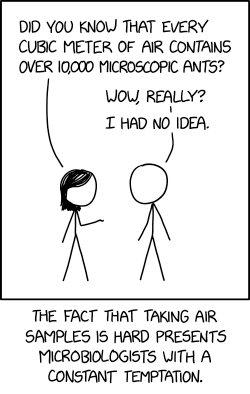Air Fact

'Wow, that must be why you swallow so many of them per year!' 'No, that's spiders. You swallow WAY more ants.'

'Wow, that must be why you swallow so many of them per year!' 'No, that's spiders. You swallow WAY more ants.'
Microbiologist Megan tells Cueball that every cubic meter of air contains thousands of microscopic ants. This is a tall tale. Adult workers in some species of the genus Carebara, the smallest known ants, can be 0.8 millimeters long, just below the 1.0 mm upper bound of what some consider "microscopic". It is therefore possible for an air sample to contain microscopic ants. However, given the subterranean, cryptic habitats typical of Carebara species, it is highly unlikely that these ants would appear in any, never mind every, air sample. Initially incredulous, Cueball accepts Megan's fib as a fact, because he doesn't have any easy way to assess what samples of air contain.
Air contains many microscopic particles, including minerals, plastics, combustion products, salt, water, pollen, spores, bacteria, fungi, and viruses. There are indeed microorganisms floating in the air, and getting air samples that will allow these microorganisms to be identified and quantified is indeed hard. Methods, with specialized collecting devices, exist that take (one hopes) known volumes of air and deposit the particles contained in that air onto sticky surfaces which are then viewed under the microscope, or onto culture media which are then incubated. The methods are time-consuming and dependent on specialized knowledge (e.g., the identification of pollen grains or spores by surface features under the microscope), and are subject to numerous biases. For example, "sticky surface" methods will likely miss bacteria, and fail to identify 'nondescript' objects, whereas culture-based methods will not detect anything that will not grow on the selected medium. The joke is that microbiologists are tempted to make up stories about what's in the air, because most people lack the data or skills to fact-check the stories.
Micro particle concentration in air varies considerably; 100 to 100,000 bacteria per cubic meter, and 100 to 1000 fungal spores per cubic meter are typical. In the comic, Megan could have sampled a 100 cubic centimeter (0.1 liter) space of air and found 1 microbe (e.g., a bacterium, a mold spore, a protozoan cyst) in it. If she assumed that this was a representative sample, Megan could extrapolate from this datum to say that there are 10,000 microbes (rather than ants) for every 1 cubic meter (1,000,000 cubic centimeters or 1000 liters). Randall has made numerous comics about dubious extrapolations, but in this case, Megan's number is within the range of microbial counts that have been made in various indoor and outdoor environments.
The title text refers to the commonly believed myth that people swallow 8 spiders a year in their sleep. Though oft quoted, it has no basis in fact, and was actually made up to see if people would repeat the rumor without checking the original source. Bona fide ants, microscopic or otherwise, would be no more likely to enter a human's mouth than spiders, while Megan's microscopic ants would mostly wind up in the lungs, not the stomach, where (one hopes) the immune system would take care of them.